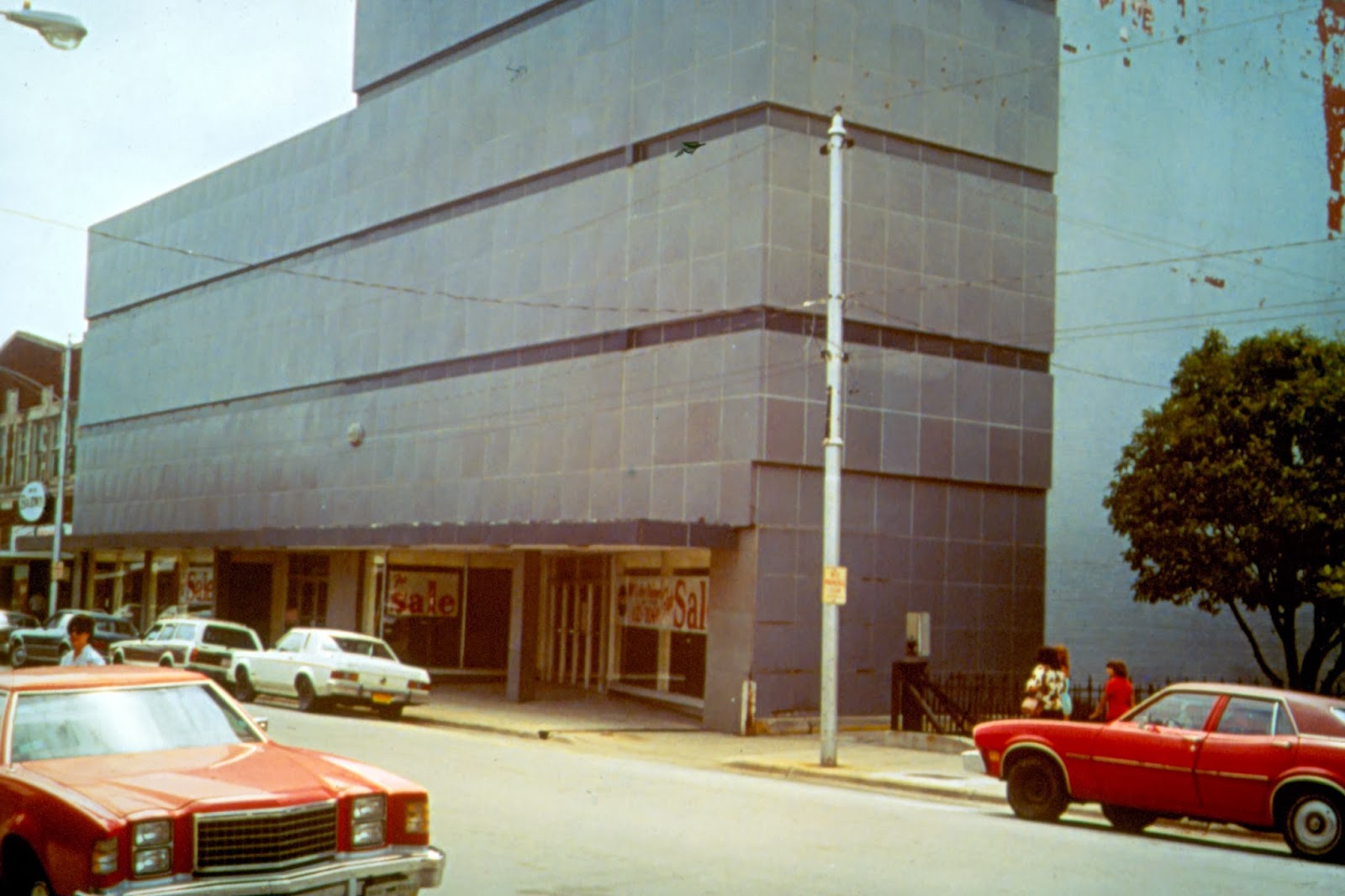 |
| The Belk Building in pre-rehabilitation days. |
 |
| The O.Marks building at 233 Middle St. is shown in 1988 after its rehabilitation was complete. |
Following his death in 1921, business declined and the firm closed its doors in 1927. The building remained vacant for four years until it was used as a Chrysler dealership. In 1937, Belk purchased the building and replaced the original storefront with large tin panels to “modernize” the façade and replaced the windows with glass brinks in the 1940s and 1950s.
The two story section on the south side was built in 1927 for the Coplon Investment Company and occupied by Montgomery Ward until 1964 when it was leased by Belk to expand its department store. The same large metal blocks were added to that façade to unite the two buildings into one, creating a major anchor building in the central business district.
In 1979, Belk joined in the exodus to the suburbs and relocated in the new Twin Rivers Mall. The large 57,000 square foot monolithic building added to the growing number of vacant deteriorating buildings and downtown’s decline.
At the June 1980 Swiss Bear Board meeting, finding a tenant became a priority when Ella Bengal, board member and alderwoman, stated she felt Swiss Bear should seek a tenant for the vacant Belk Building.
During that year, Swiss Bear monitored investor activity of those interested in leasing or buying the building and were spurred into action in February 1981 when the Board learned a company from Jacksonville planned to purchase the building for use as an adult entertainment center.
At the February 1981 Board meeting, Charles Blythe’s motion to pursue purchasing the building, passed unanimously. Jay Smith, Doug Davis, David Henderson, Dell Ipock, Dabney Coddington, Bill Edwards and Newsom Williams were authorized to secure a 90 day loan from NCNB and Jay Smith agreed to underwrite the loan interest.
To acquire the $20,000 option on the building, Swiss Bear raised $15,000 and the New Bern Preservation Foundation joined the effort contributing $5,000. With the support of four local banks, BB&T, NC National Bank, Wachovia and First Citizens Bank, Swiss Bear acquired the property. Belk donated their half of the building and Swiss Bear purchased the adjacent portion from the Coplon family at a bargain sale for $150,000. The banks allowed Swiss Bear to pay on the loan, interest only, until the building was sold.
A recruitment team developed guidelines that clearly defined the use of the building with restrictions preventing an undesirable use of the building. The metal façade would have to be removed from both buildings and the exterior rehabbed according to the specifications of a façade study. The selling price was $175,000.
In November of 1982 a Low Interest Loan Pool was formed with the City, Swiss Bear and the four banks for the purpose of allowing merchants to borrow money for building improvements at 71 percent of the prime interest rate. A federal law stating banks did not need to pay tax on interest gained from loans made in specified redevelopment areas (four core blocks bounded by Tryon Palace Drive, Craven, Hancock and Broad Streets) made it possible for banks to lend at a lower interest rate. Each bank contributed $500,000 and the City’s final approval was needed for all loans. The creation of this loan pool was the deciding factor in the eventual sale of the Belk building.
By December 1983, Swiss Bear had $131,000 invested in the building. Although it had been shown a number of times, no real interest was generated until Swiss Bear took a new approach working with the banks with a syndication method of financing. The banks also increased the line of credit for Swiss Bear so an architectural survey, a financial analysis, feasibility and other studies could be undertaken.
In 1984, five local businessmen, Lonnie Pridgen, Jr., Tom Karam, Gordon Parrot, Chick Askew and Joe Alcoke created the O. Marks Partnership and purchased the building for $200,000.
The original goal was to develop the building into a first-floor retail mall and offices on the upper floors.
The major $2.2 million extensive renovation restored most of the original exterior and interior. O. Marks Mall opened in 1986 with eight specialty retail shops and offices on the upper floors.
Although downtown was gradually beginning to turn around, the lack of pedestrian traffic needed to support the shops led to all but one closing within several years. Recruiting businesses to lease the empty spaces was very challenging, however community support for the project led to leases with the New Bern Chamber of Commerce, Neuse River Council of Governments, Swiss Bear, Weyerhaeuser and other local businesses that relocated into the building.
When the U.S. Postal Service made the decision to move out of the Federal Building (corner of Middle and New Street) to their new facility on Glenburnie Road, the downtown business owners lobbied for a downtown post office branch which was opened in the O. Marks Building. Currently the mix of businesses on the first floor includes several retail shops, a sandwich shop, offices, the post office and offices on the upper floors with 94% occupancy.
The rehabilitation of this building by the O. Marks Partnership, who faced financial challenges for many years, was key to moving the revitalization effort forward. This significant structure, a downtown anchor building, is an example of how critical private investment was to downtown’s recovery.
We commend the men who formed the O. Marks Partnership for their commitment to this key project and downtown’s recovery.
